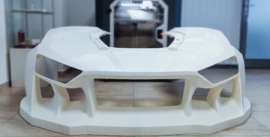 جدید
جدیدکوچکترین ساختار مشبک جهان
کوچکترین ساختار مشبک جهان
[box type=”shadow” align=”alignright” ]
دانشمندان موسسه فناوری کارلسروهه ساختار مشبکی را تولید کرده اند که به ادعای آن ها کوچکترین از نوع خود در جهان است. تولید این ساختار با فرآیند لیتوگرافی سه بعدی آغاز می شود و ساختار به وسیله لیزرهای کامپیوتری و لاک نوری ایجاد می شود. [/box]
دانشمندان موسسه فناوری کارلسروهه ساختار مشبکی را تولید کرده اند که به ادعای آن ها کوچکترین از نوع خود در جهان است. این ساختار از ستون ها و بست هایی تشکیل شده است که کمتر از 10 میکرون طول و کمتر از 200 نانومتر قطر دارند. اندازه کل این شبکه سه بعدی کمتر از 10 میکرون اما استحکام آن از بسیاری از جامدات بیشتر است.
تیم پژوهشی موسسه فناوری کارلسروهه (KIT) می گوید که نسبت استحکام به دانسیته این ماده به مقدار جدیدی برای فراماده ها رسیده است. فراماده ها، موادی هستند که به دست بشر ساخته شده اند و خواص آن ها در طبیعت یافت نمی شود. علت مقدار بالای نسبت استحکام به دانسیته ابعاد کوچک این ساختار است که یک پنجم سایر فراماده هاست. این سازه از کربن شیشه ای ساخته شده است که از کربن خالص بدست می آید و خواص آن مجموعه ای از خاصیت های شیشه ای، سرامیکی و گرافیت است.
تولید این ساختار با فرآیند لیتوگرافی سه بعدی آغاز می شود و ساختار به وسیله لیزرهای کامپیوتری و لاک نوری ایجاد می شود. این فرآیند برای ساختن ستون هایی به طول 5 الی 10 میکرون و قطر 1 میکرون کاربرد دارد بنابراین با استفاده از فرآیند زجاجی کردن و انقباض، ساختار نهایی حاصل می شود. تیم پژوهشی KIT ادعا می کنند که از این روش برای نخستین بار در پیرولیز ساختار های میکرونی مورد استفاده قرار گرفته است.
پیرولیز فرآیندی است که در حین آن ماده در غیاب اکسیژن در معرض دمای بالا قرار می گیرد. در این پروژه ساختار ایجاد شده درون کوره قرار داده شده و در معرض دمای 900 درجه سانتی گراد قرار گرفته است. در این شرایط پیوندهای شیمیایی آرایش مجدد پیدا می کنند و تمامی عناصر به جز کربن از ساختار خارج می شوند. این فرآیند سبب می شود تا کربن بی نظم درون ساختار به شکل شیشه ای درآمده و موجب انقباض شبکه شود.
در تست های بعدی مشخص شد که این ساختار خواص قابل توجهی را تحت فشار از خود نشان می دهد. پروفسور اولیور کرافت یکی از پژوهشگران این پروژه می گوید: ” بر طبق نتایج بدست آمده، خاصیت تحمل بار این ساختار بسیار مشابه با حد تئوری و بسیار بالاتر از کربن شیشه ای است. تنها الماس استحکام بیشتری را از خود نشان می دهد.” تیم پژوهشی معتقد است که چنین ریزشبکه هایی می توانند کاربردهایی در الکترودها، فیلتر های صنایع شیمیایی یا تجهیزات نوری در مخابرات کاربرد داشته باشند.
جزئیات این پژوهش در شماره اخیر Nature Materials به چاپ رسیده است.
[box type=”info” align=”alignright” width=”1124″ ]منبع : www.gizmag.com [/box]
[divider]
Nanoscale lattice is world’s smallest
Scientists from Karlsruhe Institute of Technology (KIT) have created a tiny lattice they claim is the world’s smallest. Formed with struts and braces measuring less than 10 micrometers in length and less than 200 nanometers in diameter, the 3D lattice has a total size of less than 10 micrometers, but boasts a higher specific strength than most solids.
The KIT team says the lattice achieves new strength to density ratios for metamaterials (man-made materials that have properties not found in nature), thanks to dimensions that are smaller than comparable metamaterials by a factor of five. It is made of glassy carbon, which is a form of pure carbon that boasts both glassy, ceramic properties and graphite properties.
Production of the lattice started with an established 3D lithography process, is which the structure is hardened in a photoresist by computer-controlled lasers. This process is limited to producing struts ranging from around 5 to 10 micrometers in length and 1 micrometer in diameter, so the team then vitrified and further shrunk the lattice through –in what they claim is a first for the manufacture of microstructured lattices – pyrolysis.
Pyrolysis involves exposing material to high temperatures in the absence of oxygen. In this case, the lattice was placed in a vacuum furnace and subjected to temperatures of around 900° C (1,652 °F), causing the chemical bonds to reorient themselves and all elements with the exception of carbon being removed from the lattice. This leaves the unordered carbon, in the form of glassy carbon, forming the shrunk lattice structure.
In subsequent testing, the researchers found this lattice boasted remarkable properties of stability under pressure.
“According to the results, load-bearing capacity of the lattice is very close to the theoretical limit and far above that of unstructured glassy carbon,” says Prof. Oliver Kraft, co-author of the study. “Diamond is the only solid having a higher specific stability.”
The team believes such microlattices could potentially find applications as electrodes, filters in the chemical industry, or optical components in telecommunications.
The first author of the study was Dr.-Ing. Jens Bauer, who was also involved in previous work at KIT in which a microstructured framework was produced that was less dense than water, but as strong as steel.
The paper detailing the Bauer and the KIT team’s latest work appears in the journal Nature Materials.










دیدگاه کاربران